Secrets Of Washington’s Ethereal Lupine Fields

Have you ever wondered where to find the most stunning lupine fields in Washington? These vibrant purple flowers create breathtaking landscapes that look like something out of a fairy tale. Washington offers several spots where you can witness these beautiful blooms in full glory. From the rolling hills of the Palouse to the alpine meadows of Mount Rainier, each location provides a unique backdrop for these colorful flowers. Whether you're an avid photographer or just someone who loves nature, visiting these lupine fields will leave you in awe. Ready to learn more about these magical places? Let's dive in!
Discovering Washington's Lupine Fields
Washington State boasts some of the most breathtaking lupine fields in the country. These vibrant purple and blue flowers create a stunning contrast against the lush green landscapes. If you're planning a trip to see these natural wonders, here are some must-visit spots.
1. Mount Rainier National Park
Mount Rainier National Park is a haven for wildflower enthusiasts. The park's meadows burst into color during the summer months, with lupines being a standout.
- Paradise Meadows: Known for its stunning views of Mount Rainier, Paradise Meadows is a prime spot for lupine sightings. The flowers bloom in late July to early August, creating a picturesque scene.
- Sunrise Area: This area offers panoramic views and a variety of wildflowers, including lupines. The higher elevation means the blooms appear slightly later, around mid-August.
2. Olympic National Park
Olympic National Park offers diverse ecosystems, from rugged coastlines to lush forests. The lupine fields here are a sight to behold.
- Hurricane Ridge: Accessible by car, Hurricane Ridge provides sweeping views of the Olympic Mountains and fields of lupines. The best time to visit is mid-July to early August.
- Obstruction Point: A bit more remote, Obstruction Point offers a quieter experience with equally stunning lupine displays. The flowers bloom from late July to mid-August.
3. North Cascades National Park
North Cascades National Park is often called the "American Alps" due to its rugged mountain scenery. The lupine fields here are nothing short of spectacular.
- Cascade Pass: A popular hiking destination, Cascade Pass features meadows filled with lupines and other wildflowers. The best time to visit is mid-July to early August.
- Maple Pass Loop: This loop trail offers stunning views and a variety of wildflowers, including lupines. The blooms typically peak in late July.
4. Mount St. Helens National Volcanic Monument
Mount St. Helens, known for its dramatic eruption in 1980, has since become a unique landscape where lupines thrive.
- Johnston Ridge Observatory: This area offers a fascinating look at the volcano's recovery, with lupines among the first plants to return. The best time to see them is late June to early July.
- Windy Ridge: A bit more challenging to reach, Windy Ridge offers a quieter experience with beautiful lupine fields. The flowers bloom from late June to mid-July.
5. Columbia River Gorge
The Columbia River Gorge, straddling the border between Washington and Oregon, is famous for its waterfalls and wildflowers.
- Dog Mountain: A popular hike in the Gorge, Dog Mountain is known for its wildflower displays, including lupines. The best time to visit is late May to early June.
- Catherine Creek: This area offers a variety of wildflowers and stunning views of the Columbia River. Lupines bloom from late May to early June.
6. Mount Adams
Mount Adams, the second-highest peak in Washington, offers a quieter alternative to some of the state's more famous mountains.
- Bird Creek Meadows: Located on the southeast side of Mount Adams, Bird Creek Meadows is known for its wildflower displays, including lupines. The best time to visit is mid-July to early August.
- Killen Creek: This area offers stunning views of Mount Adams and fields of lupines. The flowers typically bloom from mid-July to early August.
7. Alpine Lakes Wilderness
The Alpine Lakes Wilderness, located in the central Cascades, is a paradise for hikers and wildflower enthusiasts.
- Rachel Lake: A challenging hike, Rachel Lake rewards visitors with stunning views and fields of lupines. The best time to visit is mid-July to early August.
- Snow Lake: One of the most popular hikes in the Alpine Lakes Wilderness, Snow Lake offers beautiful lupine displays. The blooms typically peak in late July.
8. Goat Rocks Wilderness
Goat Rocks Wilderness, located between Mount Rainier and Mount Adams, offers rugged beauty and stunning lupine fields.
- Snowgrass Flats: A popular destination for wildflower enthusiasts, Snowgrass Flats features meadows filled with lupines. The best time to visit is mid-July to early August.
- Cispus Basin: This remote area offers a quieter experience with beautiful lupine fields. The flowers bloom from mid-July to early August.
Embrace the Beauty of Washington's Lupine Fields
Washington's lupine fields offer a breathtaking escape into nature's splendor. These vibrant purple blooms create a stunning landscape that captivates visitors every year. Whether you're a seasoned hiker or just looking for a peaceful retreat, these fields provide the perfect backdrop for unforgettable memories.
Plan your visit during peak bloom season, typically late spring to early summer, to witness the lupines in their full glory. Don't forget your camera; the photo opportunities are endless. Exploring these fields not only offers visual delight but also a chance to connect with the natural world.
Remember to respect the environment by staying on designated paths and not picking the flowers. This ensures that future generations can also enjoy the beauty of Washington's lupine fields. So, lace up your hiking boots, grab your camera, and immerse yourself in the enchanting world of lupines.

